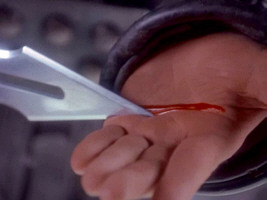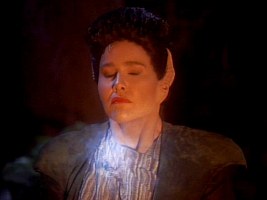Other Exobiology Inconsistencies
Humanoid GeneticsRapid or Purposeful Evolution"Strong Aliens"Pon FarrShapeshiftersMiscellaneous
Humanoid Genetics
Although the crews frequently encounter strange and previously unknown lifeforms, most Star Trek aliens are humanoid. They are bipedal and in possession of an upright posture, two arms, two legs, hands, feet, one thorax, a neck and a head with a brain located in it (see Humanoids at Memory Alpha). As opposed to the silicon-based lifeforms (like Horta in TOS: "Devil in the Dark"), let alone the variety of non-corporeal entities, all humanoids are based on organic carbon compounds and on DNA. Some of these humanoids are visually indistinguishable from humans. Others have have essentially the same features as humans, like the Bajorans. Still other aliens share their general phenotype (appearance) with humans, but have some special characteristics, like the Vulcans or Klingons. The question is how closely related all these distinct species can be and have to be from a genetic viewpoint.
We know from TNG: "The Chase" that four billion years ago the first humanoid race left a genetic code in the form of DNA strands in the primordial oceans of countless potentially habitable planets of our galaxy that would trigger the development of humanoid life. Notwithstanding the dubious science in this assumption, as genes are not suitable to hold a "program" for a development, it becomes clear that all humanoids are in fact related to some limited extent even though they evolved in nearly complete isolation. As for the degree of isolation, we may probably discount the possibility of spores traveling through intergalactic space, whereas we can't exclude the influences of possible later ancient spacefaring species.
How close can the genetic affinity of species from different planets be? We know that, based on the number of identical DNA base pairs, the human and the chimpanzee genomes are 95% identical (up to 98% according to some sources). Whilst this is no surprise, humans and chimpanzees can't interbreed, whereas it is possible (albeit with some physical or genetic manipulation) among many of the known humanoid species. Can the products of entirely separate evolution processes of four billion years be more similar than a common ancestry that dates back only a few million years? Obviously we must seek the answer in the genetic "program" of "The Chase" and in the medical technology of the 24th century that may theoretically allow various other, potentially ethically questionable crossbreeds as well (such as with animals). We have to bear in mind that in the 22nd century interbreeding of humans and Vulcans (with their copper-based green blood as stated in TOS: "Obsession") was not yet considered possible (ENT: "Future Tense"), and that it took until the 24th century for humans and Klingons to have common children (TNG: "The Emissary"). In some other cases it seems like different races can interbreed naturally though. Tora Ziyal, for instance, as well as other Cardassian-Bajoran hybrids of the time of the occupation, were commonly regarded as "accidents" and hence conceived without the support of technology.
However, if all humanoids were that closely related that they could interbreed with or without the help of medical technology, why wasn't the necessary genetic similarity recognized much earlier, considering that the humanoid genomes will have been largely decoded until then and that comparative genetic analysis is very easy with the technology of the 24th century? The episode "The Chase" plausibly shows how the additional code sequences found on the various planets are gradually assembled and decoded by Professor Galen (who, by the way, must have been an extraordinarily talented amateur geneticist, considering that archeology was his actual profession) and the various starship crews. But what about the humanoid genomes that must have been known for a long time? Beverly Crusher is surprised that the genomes from the various planets (many of which are not even taken from humanoids) have compatible base pairs allowing to assemble the DNA strands to the ancient program. This indicates that the humanoid genomes of different origin are commonly believed to be entirely dissimilar and that the kinship or even compatibility was previously unknown. And, as Geordi notes, that the this can't be a random compatibility.
Convergent evolution or homoplasy is a phenomenon whereby distinct species, under similar environmental conditions, may acquire similar features although they are not closely related (see Convergent Evolution at Wikipedia). The similarity of the streamlined bodies of sharks and dolphins is one of the best-known examples of convergent evolution. The same could apply to humanoid species on planets that have been isolated for billions of years, and it ultimately wouldn't even require common ancestors to explain why all humanoids are largely alike. In case of convergent evolution the various humanoid species may possess entirely different genomes; theoretically some of them may not even be based on DNA but on an analogous hereditary coding in silicon-based compounds, for instance. Convergent evolution, however, is a possibility and not a necessity. Moreover, even if the bipedal upright humanoid were the perfect lifeform to develop intelligence and technology for which there is no proof except for perhaps the statistics of the Star Trek Universe, the process of evolution does not really create "perfect" lifeforms, but just organisms which are just sufficiently fit to survive and procreate.
If we believe in the premise of "The Chase", it is a possibility that the ancient humanoids have mastered a technology allowing them to incorporate a seemingly random homoplasy in their "genetic program" in addition to the natural process. In other words, a routine that creates similar humanoid characteristics even if they don't look like they are genetically related. And while they were at it, they may have taken provisions to make their creations "invisibly" compatible for the case that they should meet and should want to interbreed. This assumption is mere speculation, but it is not more far-fetched than the predetermined evolution and the ancient message in the artificial genetic code of humanoids.
An alternative explanation for the fact that some humanoid species can interbreed may be that other ancient races spread their own or other genes across various planets, and maybe particularly neighboring planets like Cardassia and Bajor. There are ancient races like Sargon's people who may have influenced Vulcan prehistory (TOS: "Return to Tomorrow"), the Preservers who saved Native American Indians as seen in TOS: "The Paradise Syndrome" and the "Sky Spirits" who maintained relations with Chakotay's tribe (VOY: "Tattoo"). They may be responsible for other parallel and seemingly random developments, such as Miri's planet that is an exact copy of Earth (TOS: "Miri"), for Hodgkin's Law of Parallel Development that is accounted responsible for the Roman society in TOS: "Bread and Circuses" or for the existence of "proto-Vulcan" races like the Mintakans (TNG: "Who Watches the Watchers?"), who most likely already existed before the Vulcans themselves developed space travel. A multitude of ancient advanced races carrying mere DNA or whole populations through the galaxy may explain why the Star Trek Universe looks like it does. Still, the problem remains to explain why the discovery that all humanoids are related is such a stunning surprise in TNG: "The Chase". Maybe Cardassians, Klingons or even the Federation just didn't want to acknowledge that the galaxy had a history of intelligent life millions or even billions of years before their races even existed.
Rapid or Purposeful Evolution
It is commonly accepted in modern science that evolution does not follow a certain goal like "creating a perfect organism". It is a random process, it often leads into dead ends and only overall it creates organisms that are well-adapted to their environmental conditions. Furthermore, evolution is nothing that can possibly occur suddenly, but can only take place in the course of many generations. In Star Trek, like in many other science fiction series, these two fundamental principles have been broken several times.
The best known and most blatant violation is certainly VOY: "Threshold", where Tom Paris "evolves" to some sort of newt without any necessity and in a matter of hours. The course of the story makes it look like it were encoded in his human genes that once he reached Warp 10, he must be transformed to a newt, a lifeform which is said to constitute a future evolutionary stage of humanity. In TNG: "Transfigurations" the Zalkonian humanoid "John Doe" enters what he describes as a "new plane of existence" and also explicitly as an evolutionary process, when he undergoes a metamorphosis to some sort of "energy being". This alleged evolutionary leap is much too fast, not at all like with gill breathers who did not suddenly crawl off the water to live on dry land, but slowly learned to survive in the mudflat. Also, as there is no necessity at all for John to change the way he exists, it cannot realistically be a step in an evolutionary process. The rapid evolution that takes place on the Genesis planet in "Star Trek III", when the microbes evolve to a crustacean species and eventually to giant worms, is only a bit more plausible. Under the special conditions of this planet they may have gone through thousands of generations, although we can object that in this case time itself would have to be considerably accelerated on the planet (such as in VOY: "Blink of an Eye"), which it obviously isn't. At least the day lengths and seasons are not short enough to bring forth several generations per hour.
The reverse development to VOY: "Threshold" takes place in TNG: "Genesis", when a retrovirus activates introns, described as dormant genes, and transforms the Enterprise-D crew to "more primitive" lifeforms from their respective planets. Data says that an intron virus is responsible and that introns could include "genetic material from many different species over millions of years of evolution". While introns actually exist in the DNA and may hypothetically hold information on previous stages of evolution, how can Reginald Barclay be turned into a spider, when actually humans are unquestionably no descendants of spiders? The concept of this episode would only work if a complete "portfolio" of lifeforms and paths of evolution were encoded in our genes. In other words, it has to be "intelligent design" to be possible.
Another example of a questionable evolutionary theory can be found in ENT: "Dear Doctor". The premise of this episode is that there are two humanoid species on the same planet, namely the Valakians and the Menk. The Menk are somewhat less developed, or so the Valakians think. The Valakians are suffering from a global plague that leaves the Menk unaffected. Dr. Phlox draws the conclusion that by providing a medication for the Valakians to survive, he would deny the Menk what he sees as their "natural evolution". In other words, in his view the Menk with their "stronger genes" are supposed to become the dominating species of the planet. While this stance seems to be at least a crude interpretation of Darwin's principle of the survival of the fittest, it neglects that no step in evolution can be predetermined. There is nothing like "good" or "bad" genes that would allow one species to dominate another one. Something like that exists only in racist delusions. While no scientific principle has been visibly violated in the episode, it still suffers from Phlox's scientifically flawed and ethically wrong stance.
TNG: "The Chase" may have been intended to continue the tradition of Roddenberry's anti-religious attitude, as it rebuts the idea of a religious genesis in which a higher being created all life. Yet, the episode provides even more evidence of intelligent design in the Star Trek Universe. As already described in the above chapter about humanoid genetics, a vastly advanced species laid the foundation for all humanoid life in the Milky Way Galaxy four billion years ago. If we acknowledge the idea that these aliens could artificially alter the course of genetics without any geneticist noticing, it is hard to justify that a god or "nature" has not done or is not still doing the same in the evolution of humans or other lifeforms. So inadvertently Star Trek promoted the idea of "intelligent design" on a couple of occasions -- whatever we may think of this theory.
"Strong Aliens"
"Species 5618, human. Warp-capable, origin grid 325, physiology inefficient, below average cranium capacity, minimum redundant systems, limited regenerative abilities." (Borg Queen in VOY: "Dark Frontier")
For some reason most humanoid aliens (not to mention the Borg) seem to be physically stronger than humans, although they usually look very much like humans. In addition, they have longer life spans, better developed hearing and sight and sometimes other superior mental and physical capabilities. All of the above seems to apply to Vulcans, who have excellent minds (and mental discipline), are telepathic, are stronger, are able to hear a broader range of frequencies and have self-healing capabilities. Klingons are at least much stronger and live much longer than humans (Kang, Koloth and Kor are still going into battle at the age of 140something!), and they have many redundant systems in their bodies (TNG: "Ethics").
One question is why such a puny species like ours could have ever come so far and could have survived so long at all. Well, in the process of evolution strength or intelligence is not the primary criterion, but it is rather the ability to adapt and to reproduce, and this is where humans are apparently very efficient still in the 24th century. "Evolution" on a galactic scale is only in its very early stage, so we should not compare humans to aliens in this respect - aside from my feeling that such comparisons would be sort of racist. Anyway, a lot of the human deficiencies seem to be compensated by other general qualities. Humans, for instance, are very often shown as ingenious minds, such as Richard Daystrom or Carol Marcus. This should make the human species a match to seemingly stronger aliens.
The other problem is why of all species in the galaxy our own species should be the (physically) weakest which seems unlikely. On the other hand, we have seen a couple of species that were actually weaker than humans. Humans, for instance, are taller and probably stronger than Ferengi -- although curiously the first encounter in TNG: "The Last Outpost" suggests exactly the contrary. They have better developed senses than the Vorta (as Weyoun said in DS9: "Favor the Bold" and "Treachery, Faith, and the Great River") -- although the latter have been cloned to be devoted anyway. Humans are more intelligent than the Pakleds who appeared in TNG: "Samaritan Snare". Finally, there are the Ocampa with a life span of only nine years. Summarizing, humans are not alone with their weakness. It is more likely that a strength of an alien race is pointed out than a weakness, so humans may be "inferior" to the Borg, but average compared to other aliens.
Pertaining to the phenomenon of long-lived aliens, humans have a comparably long life span among Earth's fauna, and they have this trait in common with many large mammalian species that are dependent on learning and on memory too. Diseases that affect us late in life such as Alzheimer's are not selected against by evolution. By this logic, Bendii Syndrome or similar disorders should be much more common among Vulcans, and other diseases that could be considered allegories to senile conditions would also be much more common among long-lived aliens.
Pon Farr
We know comparably much about the pon farr of Vulcan men, yet its origin or purpose is unknown. Every seven years the adult male Vulcans enter a phase of sexual desire which goes along with a state of physical and emotional imbalance (TOS: "Amok Time", "Star Trek III"). This is described as plak tow which translates as "blood fever". During this time the men need to mate with a Vulcan woman. Otherwise they will likely die (VOY: "Body and Soul"). An alternative to resolve pon farr might be a ritual fight (VOY: "Blood Fever"). The plak tow generally seems to last at most two or three days. Seeing that only some 2000 years have gone by since Surak, it is very unlikely that evolution has been forcing the now emotionally disciplined Vulcans to reproduce at least every seven years to preserve their species, even if Spock suggests something like that in "Amok Time". Rather than that, the seven years may be a cycle from prehistoric times, and the philosophy of Surak may only emphasize the contrast between the few days of pon farr and the long phase between two pon farrs.
So far pon farr was only known as a peculiarity of Vulcan males. For what statistics are worth, all four times it was on screen prior to Enterprise only Vulcan men underwent pon farr (not counting the Doctor's fantasy in VOY: "Tinker, Tenor, Doctor, Spy"). Moreover, Saavik's statement from "Star Trek III" is that "Vulcan males must endure it every seventh year of their adult life". If we take this literally, it doesn't rule out that females may go through pon farr too. But implicitly Saavik is saying that it is just the men, especially since she is a woman. Otherwise she would much rather speak of "Vulcans" instead of "Vulcan males". Anyhow, a hint that Vulcan females may have pon farr too can be found in VOY: "Blood Fever". We know that Vorik somehow "infects" B'Elanna with pon farr, causing a similar condition in her as in Vulcan men. Vorik wonders how this could be possible in a non-Vulcan. So there is something like female pon farr, although here it sounds like a condition triggered by Vulcan males and not an independent seven-year cycle. The only definite evidence for female pon farr can be found as late as in ENT: "Bounty". Here microbes cause a premature pon farr in T'Pol, implying that it is indeed recurring. She acts exactly like the male members of her species during that phase and as B'Elanna in "Blood Fever", attempting to mate with Phlox. It doesn't seem to matter that Phlox is an alien, just like it isn't an obstacle either for Vorik to choose B'Elanna.
We do not actually know whether the pon farr is the really only phase of sexual activity in the lives of Vulcans and, even more importantly, whether it is the only phase when Vulcans (either males or females or even both of them) are fertile. In TOS: "The Cloud Minders" Droxine asks Spock: "You only take a mate once every seven years?" Spock tells her that the "cycle is biologically inherent in all Vulcans. At that time, the mating drive outweighs all other motivations." He does not explicitly confirm that it is the only time of mating though. Curiously the lyrics of the Doctor's Verdi parody from "Tinker, Tenor, Doctor, Spy" implicitly say that Vulcans don't have sex in the seven years between the pon farrs: "Tuvok, I understand. You are a Vulcan man. You have just gone without for seven years about." But we shouldn't take that too seriously. The same goes for a remark that Mirror Trip made in ENT: "In a Mirror, Darkly": "How many years is it until your pon farr comes around again?" In other words, he implies that there is a regular cycle of the female pon farr. There are some indirect accounts that, while Vulcans may have sex whenever they want to, pon farr may be a preferred time. It is a preferred time to marry too. Tuvok and his son marry during pon farr, and Spock was supposed to. Tuvok's daughter was conceived in his 11th pon farr, according to Tom in VOY: "Alice". And Tuvok's son went through pon farr with his wife, conceiving a daughter, as Neelix told Tuvok in VOY: "Hunters". Perhaps the Vulcans simply neglect contraception during their plak tow?
If, however, there were a phase of fertility only every seven years, how in the world could a Vulcan couple ever have children? The chance that the pon farrs of the man and the woman coincide would be about 1/850 (assuming a duration of three days), and so would be the chance for a Vulcan woman to become pregnant. Statistical fluctuations of the seven-year pon farr period would not improve the overall chance ever to conceive a child either. Hence, there should be some method that allows Vulcan men and women to be in pon farr at the same time. Possibly the bonding of a Vulcan couple that occurs already in their early days as children could help "synchronize" the pon farr. Alternatively, even if it is a somewhat sexist notion, the female pon farr may always be triggered by male pon farr. We do not actually learn how the microbes was responsible for T'Pol's unscheduled pon farr. But maybe it was exactly the same effect that a Vulcan male in that state may have had on her. The same with Vorik who managed to transfer his pon farr even to an alien woman.
Still, pon farr is easier to explain if it we assume that Vulcans can mate any time, only that they just have to every seven years. Since two of Tuvok's children are no more than three or four years apart, one of them can't have been conceived during pon farr. If this is true, the pon farr would rather not be a precaution to get the disciplined Vulcans to mate at least every seven years to preserve their species. The true reason for pon farr remains nebulous.
Interestingly, there is a condition called musth of male elephants resembling the pon farr and the plak tow. Musth occurs in irregular intervals for about one week every year. During that time the testosterone levels are elevated 60 times. The bulls may father children any time, only during musth there is a special urge.
Shapeshifters
We know next to nothing about the physiology of the various shapeshifters that have appeared in Star Trek, like Captain Garth from TOS: "Whom Gods Destroy", Martia from "Star Trek VI" or Salia from TNG: "The Dauphin". But we learn a great deal about the abilities of the Changelings or Founders, only that some key questions remain unanswered.
The Founders are some kind of "animate fluid" capable of assuming whatever shape is desired or required. Obviously, shapeshifting is not restricted to taking the shapes of lifeforms, but any kind of inanimate matter can be reproduced as well. The principal question is whether a shapeshifter only imitates the appearance of an existing object or really becomes this object. In the first case, the shapeshifter could retain his fluid state in essence and would only change his outer appearance so as to deceive simple sensors such as the five human senses. This idea corresponds with Odo's statement that he has no humanoid digestion while he maintains a humanoid shape, so nourishment is useless for him. More sophisticated sensors like in tricorders could be designed to expose the shapeshifter, for instance by simply revealing the lack of activity of inner organs. However, detecting shapeshifters turned out very hard in DS9: "The Way of the Warrior" and DS9: "Homefront". The shapeshifter disguised as Dr. Bashir even spent a few weeks on the station without raising suspicion. If the second assumption applies, the shapeshifter would have to create the complete object in order to deceive any available sensor.
Side note In DS9: "Homefront" it is the common method to unmask shapeshifters by taking a blood sample which would lose its coherence once separated from a changeling. Joseph Sisko claims that a changeling could take a person's blood and hold it inside themselves, dispensing a few drops to fool a blood test. But without a constant oxygen supply, wouldn't the blood congeal? Or could the changeling replicate a working system of lungs and internal organs to keep it supplied with oxygen? Wouldn't the blood screening include a DNA test? And even if Joseph is right, why does Starfleet, as well as the Klingons, keep using blood tests right through the rest of the series as a way to find Founders?
Speaking of inanimate objects, what happens to Odo's communicator when he morphs? It seems that the device is always part of Odo himself, since it always melts together with the rest of him. It would be quite miraculous if he could recreate not only the look but the complete function of something extremely complex like a subspace transmitter. Or is this only an illusion, and Odo actually drops the comm badge outside our field of view? Maybe he always takes the communicator inside in which case he could never become something very small.
If shapeshifters are able to morph to whatever they like to, they would have to convert matter not only on the molecular level (chemical reaction), but even on the nuclear level (nuclear fission/fusion) in order to create the required composition of chemical elements. A non-radiating processes would have to be employed, for the radiation would otherwise reveal the shapeshifting. Even if they consume only few power, what is their power source anyway? If the shapeshifter becomes an inanimate object, the question arises what happens to the key components that make them a lifeform, namely their memory and their conscience (or soul)? Shapeshifters would be more powerful than any conceivable replicator if they are really able to convert themselves to someone or something completely different. Hence, the Jem'Hadar would have a good reason to regard them as gods.
Another problem is what happens if the shapeshifter imitates an object with a larger or smaller volume than their original fluid volume. It is obvious that Odo's bucket is much smaller than the volume of his human body, but he is also able to imitate a tiny rodent or bird. Either Odo would have to inflate/compress his volume or collect/drop additional matter every time he switches to a larger/smaller volume. On one hand, his liquid mass shouldn't be much higher than 20kg, otherwise Lwaxana Troi would have had problems to keep it together in DS9: "The Forsaken". On the other hand, Croden complained about Odo's weight in DS9: "Vortex", where he was just able to carry the shapeshifter, which points to a considerably higher weight. A light-weight Odo would be faster, yet weaker than other humanoids. Moreover, due to his low density he could be easily detected by sensors, no matter if his conversion to the human shape is complete or only partial. Since it is quite improbable that a shapeshifter abandons part of his matter, any imitated object is supposed to have at least the weight of the pure fluid. Even if the matter can be compressed, there has to be lower limit for shapeshifting, for a 20kg sparrow would hardly be able to fly. In DS9: "The Begotten" the baby Changeling is much smaller than Odo's liquid mass, and Odo says it would still grow. The human Odo can carry the container with ease, so the infant may not weigh more than a few kilograms. This doesn't reveal anything about Odo's mass, however.
The question why shapeshifters in general and Odo in particular have difficulties in imitating a human face is not as grave as the above problems. Still, it is not evident. Odo can reproduce extremely complex surface structures, but not a simple nose and ears (DS9: "Past Prologue", "Shadowplay", "The Begotten"). Perhaps this is a common psychic problem of the Founders who were once scared by the Solids and did not want to be like them. No lifeform is perfect. Another possible explanation is that Odo has consciously chosen his appearance to be an imperfect imitation of a human face. Upon meeting him, the other Founders may have adopted his look whenever they reveal themselves to Alpha Quadrant humanoids. Some of them are obviously capable of a perfect imitation (DS9: "Homefront", "Paradise Lost", the Bashir Changeling).
Miscellaneous
Klingon blood
Klingon blood has always been dark red just like human blood (and opposed to the consistently green Vulcan and blue Bolian blood). There is only one exception: "Star Trek: The Undiscovered Country" where it is shown as pink. The purported real-world reason for this anomaly is that the producers were anxious to avert an "R" rating for their movie, and they decided that pink blood would not look as harsh as if it were red. We may discard this one-time inconsistency although it remains rather prominent.
It has been conjectured that the Klingon blood, under zero-G condition like aboard the Qo'noS Wa' (Kronos One) after the torpedo impact, does not congeal easily and might appear in a different color than in normal gravity. But when McCoy attempts to treat Gorkon, the blood is still pink. When congealed Klingon blood is found on the antigrav boots, it is pink just as well. Alternatively, as Klingons possess two livers, there may be an excess of porphyrin in the blood that causes it to fluoresce under certain lighting conditions (such as some starship lighting systems).
In a scene on Khitomer that was not in the original theater version of "The Undiscovered Country" Colonel Worf examines the body of the assassin who attempted to kill the Federation President. He states, "This is no Klingon blood" -- the assassin being Colonel West who has first appeared in yet another additional scene. How could Worf know if the two looked much alike? If we ignore the colors or find excuses that Klingon blood, under certain conditions which may include but not be restricted to zero gravity, may appear pink, perhaps the smell could tell it apart from human blood.
 In Star Trek Discovery, the revised Klingons have purplish red blood, possibly in an attempt to find the middle way between red and pink.
In Star Trek Discovery, the revised Klingons have purplish red blood, possibly in an attempt to find the middle way between red and pink.
Vulcan aging
"Live long and prosper." -- We know that Spock (born 2230) is about the same age as Kirk (born 2233) so it is easy to compare their aging processes. It is obvious that until 2293 when they can be seen together for the last time in "Star Trek: The Undiscovered Country" the Vulcan/human Spock has aged just like the human Kirk -- obviously because Shatner and Nimoy are the same age (both born 1931), and are about as old in their roles in the movies as in the real world. Spock looks still the same 76 years later when he appears in TNG: "Unification" at the age of 139. His father Sarek (born 2164 as established in TNG: "Sarek"), on the other hand, ages considerably as late as between the ages of 104 (TOS: "Journey to Babel", 2268) and 129 ("Star Trek: The Undiscovered Country", 2293). We may easily explain this slight inconsistency with Spock being only half-Vulcan. Ironically, considering that if anyone the half-Vulcan is supposed to age faster, Mark Lenard (1924-1996) was just six years older than Nimoy although this never impaired their roles as father and son.
Yet, we know the birth dates of two other prominent Vulcans who appear to be a lot younger than Spock or Sarek at the same ages, respectively. Tuvok must be significantly older than 100 years as of 2375 (VOY: Gravity). Yet, he looks just as old as Tim Russ who was 43 years old at that time and who was not wearing special make-up except for the Vulcan ears. T'Pol, born in 2088 (ENT: "Zero Hour"), is 63 when Enterprise goes on the first mission. She is played by Jolene Blalock who was just 26 years old at that time.
It is possible that Vulcans age in more pronounced stages than humans, in stages whose duration is subject to vary considerably. No offense to Mark Lenard or Leonard Nimoy, but perhaps the aging is more rapid in Spock's family. We also have to bear in mind that human characters generally do not look younger than the actors who play them -- although we might optimistically expect that with a prolonged lifespan of some 130 years people do not only live longer but also look younger than they would in the 21st century. The only notable exception is Captain Picard who was made some ten years older than Patrick Stewart -- albeit by accident.
Reading Ferengi minds
Deanna is only half-Betazoid and an empath, not a full telepath. This is frequently cited as the reason why she can just read emotions but no clear thoughts. In TNG: "The Last Outpost" she initially says she can't sense anything from the Ferengi. However, she is capable of sensing deception from the Ferengi later in the episode, as well as in TNG: "The Battle" and in TNG: "The Price". Yet, in TNG: "Ménage à Troi" the Betazoid Ambassador says that his species is not able to read Ferengi minds. Data tries to explain this with the Ferengi brains being composed of four lobes. Lwaxana does her best to comply with the DaiMon's wishes in order to escape from the Ferengi ship in the same episode, but that may have been just a matter of female intuition and the knowledge about stimulating a Ferengi's ears. A human woman could have certainly achieved the same. The notion that Betazoids can't read Ferengi minds is reaffirmed in TNG: "The Loss" and even plays an important part in the plot of DS9: "The Forsaken". Here Lwaxana can't make out who stole her hair brooch because the thief, a Dopterian, is said to have a similar brain structure as a Ferengi.
So we have three occurrences where Betazoids can read Ferengi minds or at least their emotions, but three where they can't. Curiously, in all three cases where Ferengi minds were readable it is Deanna with her only empathic abilities. We may be tempted to conclude that it was her usually non-telepathic human half that somehow allowed her to perceive more than Betazoids ever could. Maybe the human mind can simply better be synchronized with Ferengi brain structures. Maybe it is a weak sentiment that would usually be interpreted by Betazoids as noise that Deanna can perceive? And regarding her initial failure to feel them in "The Last Outpost", they may have been just too far away or their vessel was too well shielded for her human senses.
On the other hand, the explanation given by Data in "Ménage à Troi" and once again by Lwaxana in "The Forsaken" sounds like it is the unusual brain structure that generally doesn't allow to sense anything from them. Other telepathic races may have tried it in vain too. So why of all species should humans who are neither telepathic nor have a fourfold brain bring in a particular compatibility? Maybe Deanna is a genetic godsend and her mother doesn't even know about that.
Vorta abilities
What happened to the psychokinetic abilities that Vorta Eris had in DS9: "The Jem'Hadar"? None of the Vorta that were subsequently shown had any supernatural powers. On the contrary, since they were supposed to be nothing but devote servants to the Founders, their aesthetic sense, taste and eyesight was limited, as Weyoun stated in "Favor the Bold" and "Sacrifice of Angels" and once again in DS9: "Treachery, Faith, and the Great River". It is doubtful that the Founders would clone Vorta with abilities that could possibly endanger the god-like status of the Founders.
So why is Eris the only exception? Is she actually a Founder? It was part of Eris's false back story that the Dominion was interested in the psychokinetic powers of the people from the planet Kurill that she allegedly came from. But she evidently had those abilities. Perhaps Eris was simply an intentional or accidental mutation, one that the Founders deemed useful for the particular mission, whereas the more attractive diplomat Kilana or the bureaucrat Weyoun would better go without them. And what Weyoun said about the Vorta's limited senses as well about them being ape-like before the Founders came may well have been fabricated.
Elaysians
Gravity is so low on the Elaysian homeworld that it is possible for a humanoid to "fly" without big efforts. The indigenous Elaysians have adapted to these planetary conditions to an extent that they are unable to live in normal-gravity environments. Actually, Melora Pazlar, who appears in the DS9 episode "Melora", is the first ever Elaysian to join Starfleet. The obstacles to her service on a normal ship or station are quite visible and palpable as she is forced to wear an external skeleton with servo motors to support her otherwise too weak bones and muscles. However, the Elaysians are humanoid, and there must have been an evolution at least remotely similar to other humanoids. This obviously can't have been the case on their homeworld. It seems that the Elaysians have originally come from somewhere else and were already in the possession of the technology to survive on the low-gravity planet where realistically nothing would be fit to only support humanoid life, let alone the formation of a civilization of the kind we know it. Alternatively, the planet may have been struck by a disaster of some unknown fashion in the course of which it lost most of its mass, and the Elaysians survived in a miraculous evolutionary process.
Ocampa reproduction
We know from VOY: "The Caretaker" and several other mentions that the Ocampa have an unusually short life span of just nine years on average. In addition to that, VOY: "Elogium" establishes that in the life of a female Ocampa there is only one period in which conception is possible: the elogium. In other words, a female Ocampa may give birth to just one child in her life during her elogium or to none at all. If we assume that 50% of all new-born Ocampa are female, this would halve the population or reduce it even more with every generation. They would become extinct rapidly.
It seems impossible for a species to have a natural limitation of female fertility to just one period in life. A reason for the built-in reduction of the Ocampa species may lie in the ecological disaster that the Nacene had caused on their planet and that may have forced the Caretaker to keep the population in the underground city low. To that end he may have tampered with the Ocampa's genes. But the disaster was 1500 years ago, while the Ocampa would have died out in a matter of less than 30 generations or far less than 300 years if they once counted several billions. The Caretaker may have made unknown provisions or may clone more Ocampa when they are needed, thereby compensating for even one more fateful error.
If we are looking for a natural explanation, there is only one left. Unlike it was with Kes herself and her alternate-reality daughter in VOY: "Before and After", maybe multiples are very common on Ocampa. With twin births being the average, the population could be maintained, although once again there is no evidence to support the theory.
See Also
Aliens with Human Appearance - why so many aliens look like humans
The Klingon Forehead Problem - the history of the legendary continuity problem and its new twist in Enterprise
Vulcan Mind Melds - "The culture you've come to know isn't the one I helped to create." (Surak)
Biography Inconsistencies - gaps in biographies and other anomalies
Credits
Some screen caps from TrekCore. Thanks to Capt. Cabal for pointing out Odo's communicator problem to me and Chuck for a possible solution, to MundaneXL for a theory about the Founders, to Craig Lee Chrisco for pointing me to musth as an analogy to pon farr, to Greg for suggesting the Ocampa fertility problem, to Alex for the idea to care about the "strong aliens", to Dan for pointing out that the Ferengi were initially stronger, to Mariska for an idea about Ferengi minds and to kroannon for the idea of fluorescent porphyrin in Klingon blood. Special thanks to the people at the Subspace Comms Network for discussing the pon farr problem, and to Barryg who provided several comments to the topics of wrong evolution concepts and long-lived aliens.






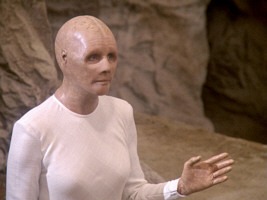
 The first humanoids in TNG: "The Chase"...
The first humanoids in TNG: "The Chase"...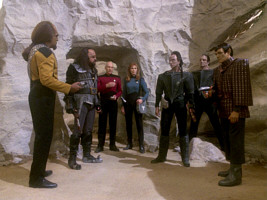
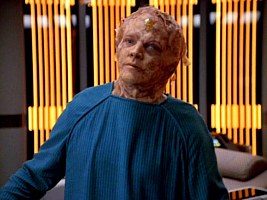
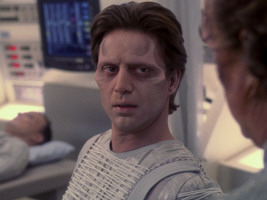
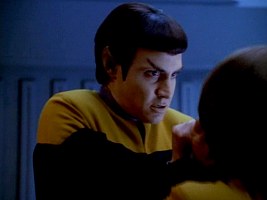

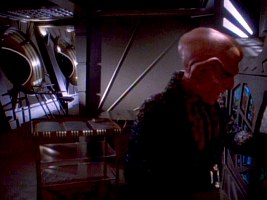

 Odo morphs to a seagull in DS9: "Homefront"
Odo morphs to a seagull in DS9: "Homefront"
